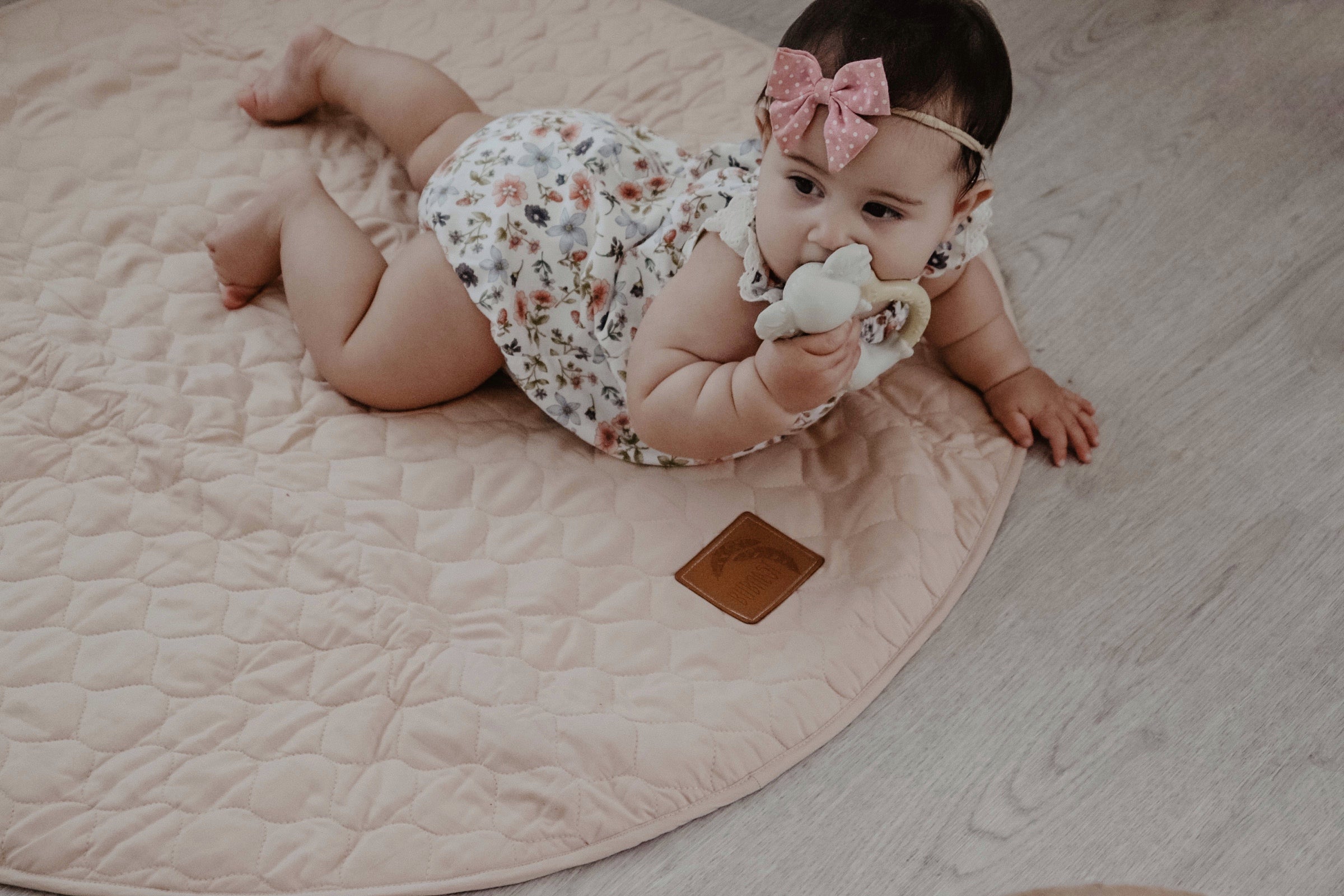As a parent, you want your little ones to have fun and be safe. But so many parents are unaware of some serious nasties in our play rooms that our babies are commonly exposed to, and can wreak havoc on their brains and bodies at a pivotal time of development. This is why avoiding exposures to harmful toxins is even more important in the first year of life, and why this article is a must-read article for any new parent.
Here’s our 6 tips to creating a healthier and low-tox playroom for your bub - and what to steer clear from!
1. Find a non-toxic and organic play mat
Something you’ll see in most playrooms of parents with small children is a play mat. As our little ones often spend a significant amount of time on these it’s important to choose a low tox option and avoid the dangerous nasties commonly found in baby mats such as PVC, polyester, Phthalates, flame retardants, BPA, Formaldehyde, pesticides and more. At such a critical time in their development these are definitely not pollutants we want our babies exposed to.
If you're looking for a solution that's good for both the environment and your child, consider a 100% organic cotton play mat. These mats are made from natural materials and will not contain harmful chemicals or dyes that can harm children.
A 100% organic cotton play mat is also beneficial because it supports sustainable manufacturing practices. When choosing an organic product, it's important to note that many companies label their products as "eco-friendly" but don't actually use sustainable manufacturing practices, or use cheap fillers such as polyester. Make sure to do some research before purchasing so that you know exactly what you're getting yourself into!
Luckily Bubnest have just launched a 100% organic cotton play mat which is available here.
2. Invest in non-toxic building blocks
It's tempting to want to buy a set of classic plastic blocks, but before you do, consider the health risks that come with having a playroom filled with PVC and phthalates. It turns out that these plastics not only contain harmful chemicals but also release those same chemicals into your air over time. This can cause respiratory problems in children, who are especially vulnerable because their bodies are still developing. Not only that, but it may also affect their ability to learn new things or remember what they've learned!
So what do you need instead? Try solid wooden blocks instead of plastic ones—they're non-toxic and don't release any fumes into the air. They'll last forever too!
3. In fact, let’s ditch the plastic toys altogether
Playroom toys are meant to be fun, but they can also be downright harmful. According to a 2017 report toys are among the top sources of toxic chemicals in our homes. That’s why it’s important to choose plastic-free toys whenever possible, especially for younger babies who frequently put them in their mouths.
Most of the dangers are related to toys made from petroleum-based plastics which are not only non-recyclable but may contain toxins like phthalates and BPA that can be released when the toy is chewed or worn down by use. PVC plastic or vinyl fabrics also contain phthalates that release toxins when heated up by our bodies' natural processes over time (like during playtime).
Phthalates have been linked to a multitude of reproductive health issues while BPA has been shown to mimic estrogen in our bodies; this can lead to hormonal imbalances which can affect fertility as well as brain development in children with long-term exposure.
Instead opt for wooden toys over plastic ones, and organic cotton stuffed animals over synthetic and polyester blend stuffed toys. Organic cotton is grown without pesticides or synthetic fertilizers, so not only is it safer for the playroom, but it also has a lower carbon footprint than conventional cotton. It’s also safer to manufacture and use because its production doesn’t require any chemicals or artificial processes.
4. Choose non-toxic and kid-safe art supplies
When it comes to art, a fun way to encourage creativity is by providing your little one with the tools they need to create their own masterpieces. But while you’re crafting an impressive collection of paints and crayons for your playroom, be sure that all of your materials are non-toxic and safe for kids.
Avoid solvent-based products like permanent and dry-erase markers, mists from sprays, and dust mixes from clays or paints, all of which are easily inhaled. Low-tox art supplies include:
- Natural finger paint, made from natural ingredients like blueberries, pumpkin and spinach (you can also check out Australian brands such as Veggie Baby Natural Finger Paint)
- Make your own natural Play Doh - all you need is 1 cup flour, 1/2 cup salt, 2 teaspoons of non-GMO Cream of Tatar, 1 tablespoon of any food-based oil (olive oil, coconut oil, avocado oil) and 1 cup of warm water - and presto!
- Non-toxic baby crayons (like these eco-friendly and low-tox options from Australian brand Little Big Learning)
5. Promote healthy indoor air in your play space and throughout your home
The best way to introduce healthy air into your play room is to open a window. As we learned in our article on 5 Tips for a Healthy Nursery, there is evidence that the air in homes can be more polluted than outdoors, even in the most industrialized areas, so open the windows as often as possible to get some fresh air.
If you need some extra help, use a HEPA air filter. A HEPA air purifier is the best way to remove dust and other contaminants from your home, which can be especially helpful in a playroom.
Alternatively, if you'd prefer not to spend money on an expensive HEPA filter system but still want cleaner indoor air in general, try switching out conventional cleaners with natural ones like vinegar and baking soda (or essential oils if they don't irritate your child's skin).
The idea behind switching over is that chemically laden cleaning agents lead to increased levels of indoor pollution since they're designed specifically for killing off bacteria while also leaving behind residue that can irritate lungs later down the line. In contrast, natural ingredients break down into harmless compounds.
6. Choose durable, natural and low-toxic furnishings like solid wood furniture
Solid wood furniture is better for the planet because it's made from renewable resources. It's also more durable than particleboard, which is typically made with urea-formaldehyde (UF) glues. Many manufacturers are phasing out their use of these adhesives due to their toxic nature and concerns over offgassing—the emission of chemicals into indoor air.
Solid wood furniture is also low-toxic because there are fewer harmful finishes used on its surface compared to other materials such as plastic.
Another low tox tip is to avoid stain-resistance treatments on furniture or curtain (i.e., Teflon) as well as antimicrobial products embedded with antimicrobial chemicals like triclosan, which in animal studies has been associated with a decrease in the levels of some thyroid hormones, and more worryingly, a higher incidence of skin cancer.
The same goes for polyurethane foam which is used as cushioning for bedding, furniture, and carpet underlay, as it off-gasses compounds into the air. Also steer clear of any furniture, rugs or upolstry containing polybrominated diphenyl ethers (PBDEs), which may contain toxic flame retardants that can affect brain development in infants and children. Instead look for furniture that uses natural fillings such as organic latex or organic cotton silk.
Final thoughts
If you take our advice and make these simple low-tox changes, your children’s playrooms will be safer, healthier places to play. And you can feel good about it! A healthier home is a happier home.



